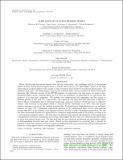| dc.contributor.author | Cowan, Nicolas B. | |
| dc.contributor.author | Agol, Eric | |
| dc.contributor.author | Meadows, Victoria S. | |
| dc.contributor.author | Robinson, Tyler | |
| dc.contributor.author | Livengood, Timothy A. | |
| dc.contributor.author | Deming, Drake | |
| dc.contributor.author | Lisse, Carey M. | |
| dc.contributor.author | A'Hearn, Michael F. | |
| dc.contributor.author | Wellnitz, Dennis D. | |
| dc.contributor.author | Seager, Sara | |
| dc.contributor.author | Charbonneau, David | |
| dc.date.accessioned | 2010-08-12T13:43:17Z | |
| dc.date.issued | 2009 | |
| dc.identifier.citation | Cowan, Nicolas B., Eric Agol, Victoria S. Meadows, Tyler Robinson, Timothy A. Livengood, Drake Deming, Carey M. Lisse, et al. 2009. Alien maps of an ocean-bearing world. Astrophysical Journal 700(2): 915-923. | en_US |
| dc.identifier.issn | 0004-637X | en_US |
| dc.identifier.issn | 1538-4357 | en_US |
| dc.identifier.uri | http://nrs.harvard.edu/urn-3:HUL.InstRepos:4341699 | |
| dc.description.abstract | When Earth-mass extrasolar planets first become detectable, one challenge will be to determine which of these worlds harbor liquid water, a widely used criterion for habitability. Some of the first observations of these planets will consist of disc-averaged, time-resolved broadband photometry. To simulate such data, the Deep Impact spacecraft obtained light curves of Earth at seven wavebands spanning 300-1000 nm as part of the EPOXI mission of opportunity. In this paper, we analyze disc-integrated light curves, treating Earth as if it were an exoplanet, to determine if we can detect the presence of oceans and continents. We present two observations each spanning 1 day, taken at gibbous phases of 57° and 77°, respectively. As expected, the time-averaged spectrum of Earth is blue at short wavelengths due to Rayleigh scattering, and gray redward of 600 nm due to reflective clouds. The rotation of the planet leads to diurnal albedo variations of 15%-30%, with the largest relative changes occurring at the reddest wavelengths. To characterize these variations in an unbiased manner, we carry out a principal component analysis of the multi-band light curves; this analysis reveals that 98% of the diurnal color changes of Earth are due to only two dominant eigencolors. We use the time variations of these two eigencolors to construct longitudinal maps of the Earth, treating it as a non-uniform Lambert sphere. We find that the spectral and spatial distributions of the eigencolors correspond to cloud-free continents and oceans despite the fact that our observations were taken on days with typical cloud cover. We also find that the near-infrared wavebands are particularly useful in distinguishing between land and water. Based on this experiment, we conclude that it should be possible to infer the existence of water oceans on exoplanets with time-resolved broadband observations taken by a large space-based coronagraphic telescope. | en_US |
| dc.description.sponsorship | Astronomy | en_US |
| dc.language.iso | en_US | en_US |
| dc.publisher | Institute of Physics | en_US |
| dc.relation.isversionof | doi: 10.1088/0004-637X/700/2/915 | en_US |
| dash.license | OAP | |
| dc.subject | planetary systems | en_US |
| dc.subject | methods: data analysis | en_US |
| dc.title | Alien Maps of an Ocean-Bearing World | en_US |
| dc.type | Journal Article | en_US |
| dc.description.version | Accepted Manuscript | en_US |
| dc.relation.journal | Astrophysical Journal | en_US |
| dash.depositing.author | Charbonneau, David | |
| dc.date.available | 2010-08-12T13:43:17Z | |
| dc.identifier.doi | 10.1088/0004-637X/700/2/915 | * |
| dash.authorsordered | false | |
| dash.contributor.affiliated | Charbonneau, David | |


